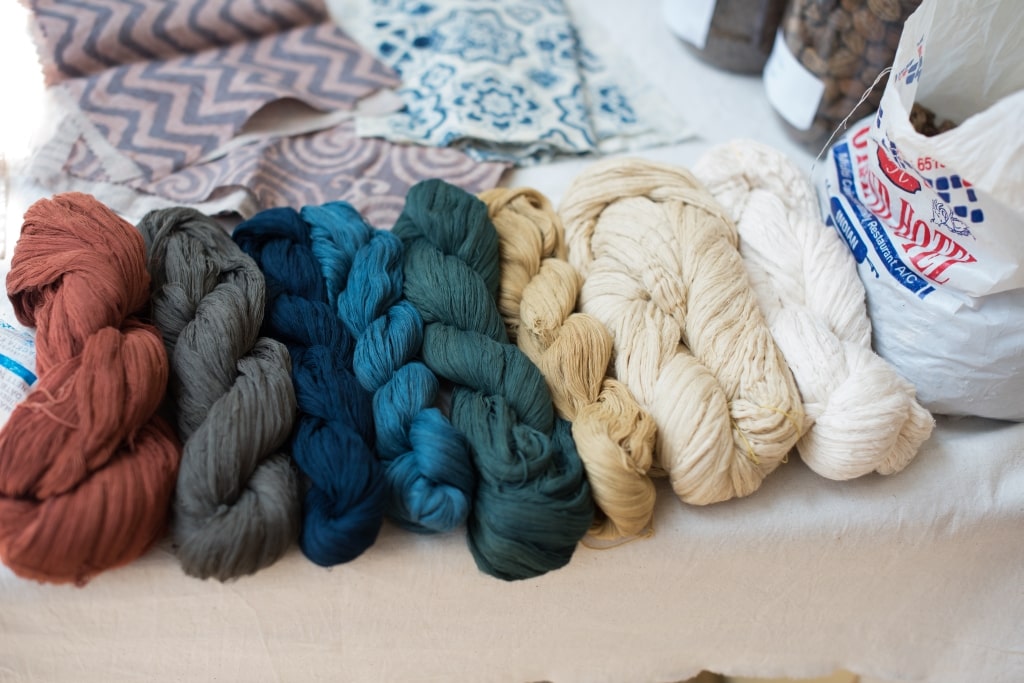
Natural dyed yarn samples. Craft and Innovation Workshop, Kalakshetra 2016
A Recipe for Crafting Color: The Revival of Natural Dyeing in South India
The craft scholar, engineer, and activist Annapurna Mamidipudi describes the impact that the smallest changes in the application of recipes for dyeing practices have on the resulting color. Her hands-on research reveals how embodied knowledge practices as a form of non-text-based experience—of tinkering and chance—contribute to the refinement of both artisanal techniques and knowledge itself, offering a craft notion of knowledge whereby theory is never detached from its materiality.
How did old recipes describing practices of natural dyeing in India from the nineteenth century come to constitute technologies for green production for the future? How did technologists and craftspeople with very different knowledge practices work together in the twentieth century to reinvent material knowledge so that modern markets could be consistently served and precarious livelihoods sustained? How does the recipe function as a metaphor that re-embeds knowledge into laboring bodies, into objects that are made over and over again, seemingly the same, yet always solving new challenges and accumulating new meaning?
Communities across the Global South continue to practice craft production even today. They are engaged in livelihoods that service modern markets, sustaining themselves, as well as their environments, and transforming craft practices into green technologies that can sustain a postindustrial world. Yet in general, their knowledge of making by hand is subservient to the scientific knowledge attributed to the mind: traditional knowledge constitutes heritage, its practitioners have no place in the future, and it is tacit and native to marginalized communities, not cutting-edge technology. In the absence of text-based theory, craft knowledge is at best considered skilled practice and, at worst, manual labor. That handloom weavers survive, and even thrive, in particular societies is a reality that can only be explained once craft is explicated as valid knowledge and contemporary weavers are understood as sophisticated sociotechnologists who innovate.
Within modern sociotechnical imaginaries that relegate craft technologies to the past, that traditional craftspeople embody knowledge that is valuable to our sustainable future is not self-evident. Drawing on my experience with innovative practices of hand-textile-producing craftspeople in South India, what follows is a short account of an experiment of reviving the knowledge of natural plants and minerals as green technology in the late 1990s. It is narrated as a set of recipes using dyes of vegetable and mineral origin, through the autobiographical lens of a fieldworker’s notes. Recipes become the site where actors from diverse fields of expertise symmetrically engage with different ways of knowing to understand, translate, and produce new insights that reinvent natural dyeing as contemporary technology. Using “recipe” as mode, method, and metaphor for knowledge, I explore a craft notion of what knowledge looks like when viewed through the practices of craftspeople.
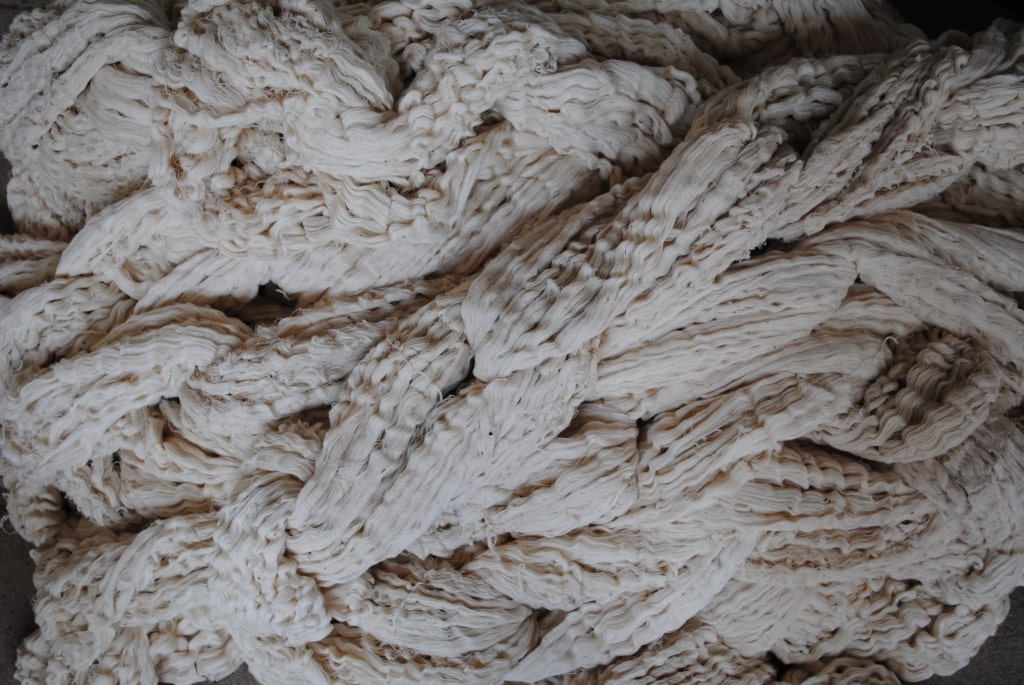
large
align-left
align-right
delete
Recipe 1: Naga Red, Rubia sikkimensis
Color: Deep brownish red
Colonial botanists George Watt and Major Trotter discuss whether Naga red, a deep reddish brown is produced using the proliferous dye-bearing plant Rubia cordifolia or another more native herb, Rubia sikkimensis. The process of extracting the dye is described as follows, by Dr. Watt: “A woman came one morning to the Residency, Manipur, bringing with her 1st two or three bundles of the root and stem of Rubia Sikkimensis, 2nd, a slab of bark of Quercus fenestrate, Roxb; 3rd . . .” He goes on to list seven different things, including the cotton yarn skeins to be dyed. He reports on what he is told by the woman—“I am told that it was necessary to prepare the second cotton skein [which was yellow], in order to give it time to dry”—and writes down his own observations: “The liquid [to be used for mordanting] tasted bitter and no doubt contained some alkali salt which I have not as yet had time to identify chemically.”George Watt, quoted in Bijoy Chandra Mohanty, K. V. Chandramouli, and H. D. Naik, Natural Dyeing Processes of India (Ahmedabad, India: Calico Museum of Textiles, 1987). From George Watt, “Note on varieties of Rubia,” in A Dictionary of Economic Products of India, vol. 6, part 1 (Calcutta: Superintendant, Government Print Office, 1892), 577. He compares his own account with that of his friend Major Trotter, to confirm that indeed the source for the Naga red used by the hill tribes of Manipur to color their clothes, hair, and decorations for spears, shields, and bamboo and cane work was Rubia sikkimensis rather than the Rubia cordifolia. It is such documentation that formed the basis of the reconstruction of natural dye expertise that was no longer in practice, with the help of K. V. Chandramouli, the author of the book this recipe is quoted in, and a small team of young activists seeking to sustain precarious craft livelihoods.
By the 1990s, when my colleagues and I, a group of young engineers, started our work, natural dyeing was a traditional artisan practice that had almost disappeared due to a steady shift to chemical dyeing over the last hundred years. Germany, which had originally synthesized color, out of which chemical technologies were born in the 1880s, had turned full circle in the 1980s, banning the import of chemical dyed fabric from India for being environmentally toxic. As part of the effort to cater to the new market for sustainable dyeing practices, we followed Chandramouli Sir, as he was referred to, as he traveled around the villages of Andhra Pradesh reintroducing natural dye practices to weaver groups. He inspired from the artisans love and frustration in equal parts; the love came from his sharing of deep knowledge of their material world, and frustration as he was always leaving out a critical ingredient as he taught them from his recipes, encouraging their natural tendency to tinker with the recipe.
Odellu, in Chinnur, in the state of Telangana, was one of the first weavers who turned natural dyer, along with his other colleagues, the members of the weavers’ society, through relearning these practices by mastering the recipes. The weavers themselves could only recall very faintly a time when dyeing practices and materials were “natural.” While most of the knowledge of the technology was lost, some of the practices still existed, but there was not enough understanding of why certain practices and not others had survived. The recipe became key for bridging the gap between knowledge of the past and the present, through efforts of scholars like Chandramouli.
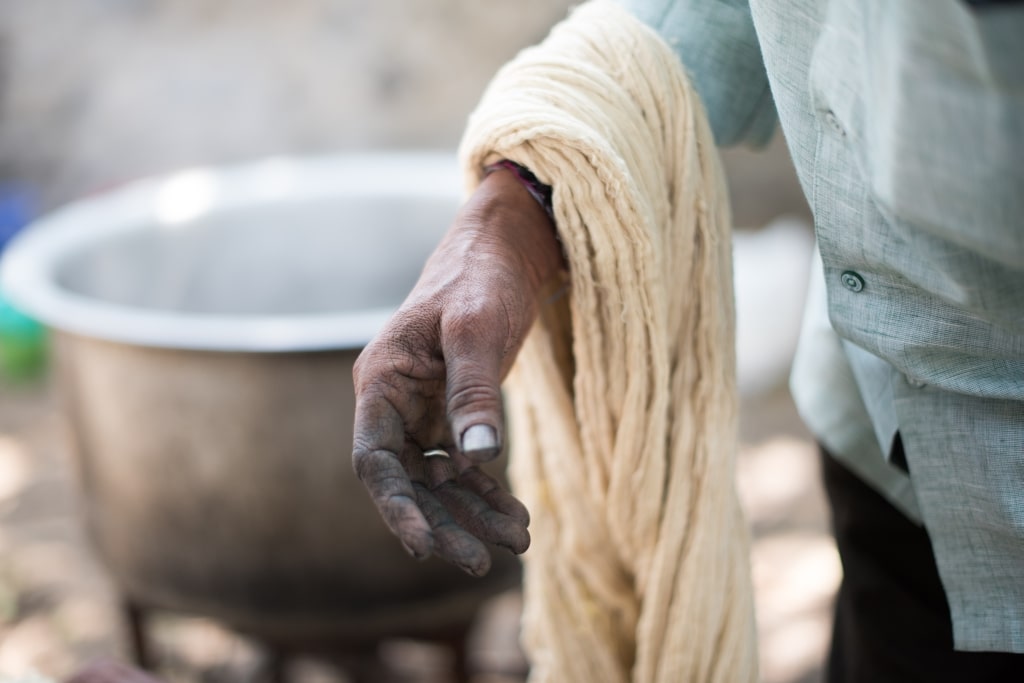
large
align-left
align-right
delete
Recipe 2: Katha, Acasia catechu
Color: Brown
For one kilogram of yarn
15 percent Katha by weight of yarn: 150 grams of Katha
1 percent copper sulfate or neeli thutham by weight of Katha: 1.5 grams of CuSO₄
Boil twenty liters of water, and add powdered Katha. Stir for twenty minutes, add copper sulfate, and dissolve well. Once the color is boiled well for twenty minutes, immerse one kilo of prewashed, moistened cotton yarn into the dyebath. Turn regularly for forty-five minutes for even dyeing. Squeeze excess water out. Wash in cold water until all excess color runs out. Dry in shade.
This was the recipe that that we fieldworkers followed, learned from Chandramouli, to dye wool in the color brown. In Eluru, in the state of Andhra Pradesh, the carpet weaver Mastan recorded the following recipe for the same color, explicating the difference between the algorithmic language adopted by the engineer and the heuristics of the craftsperson.
first, make sure you have enough washed yarn for a full day’s dyeing. Powder the dye material, so that there are no lumps, because these will stick to the yarn, and cause spots that will show up only when the yarn is dry. The quality of the Katha tends to be inconsistent, so don’t worry if you end up using too much, it is the colour that matters, not the recipe. Of course, you can only match the colour to a sample if you are experienced enough to know how the colour you see on wet yarn will look, when dry, so keep your eyes peeled, and always look at the colour when wet and then again when dry. Once the colour is cooked, dip your yarn into the dyebath immediately; overcooking the colour makes it dull. Measurements by volume are easier than by weight, so make a mental reminder to yourself on the sizes of the containers you use.Personal notes from natural dyes workshop, 1992.
This second description of the process reads as a string of solutions crafted together for problems encountered in practice. There is no separation of material and process. Unlike the first recipe, there is no linearity in the narrative: dyeing is repeated time and again until the color is right. This becomes clear when the weaver writes, “always look at the color when wet and then again when dry”—an implicit pointer to the problem-solving nature of learning while doing. The dyer instead points to time cycles—for example, one has to wait for wet yarn to dry to gauge evenness, but on the other hand, once dry, it is too late to rectify the color; you have to have paid attention when wet. The structure that this kind of time imposes on the weaver’s recipe is quite different from the structure of the first recipe for Katha.
The first uses language of percentages and unit weights and seemingly universal measures that communicate easily to other engineers. The weaver on the other hand seems not to deal with “facts” but reports on the process in a “natural” manner. But on closer observation, he too records information that functions to stabilize color. The difference in the two recipes is obtained from the nature of differences between what counts as knowledge for the engineer and for the craftsperson. It was only in the interaction between engineer and weaver as we worked together to reproduce color that the validity of both recipes as performing the same function was demonstrated. In the end, the final recipe evolved into a mix of the two, incorporating numbers but using measures that weavers were familiar with, rather than percentages and kilograms. Thus, a recipe was standardized both for a unit of one kilogram as well as in terms of warp length and weight. Rather than the engineer’s recipe becoming the source of explicit knowledge, with the craft process becoming tacit procedural knowledge, the new recipe as text comes to mediate different ways of knowing.
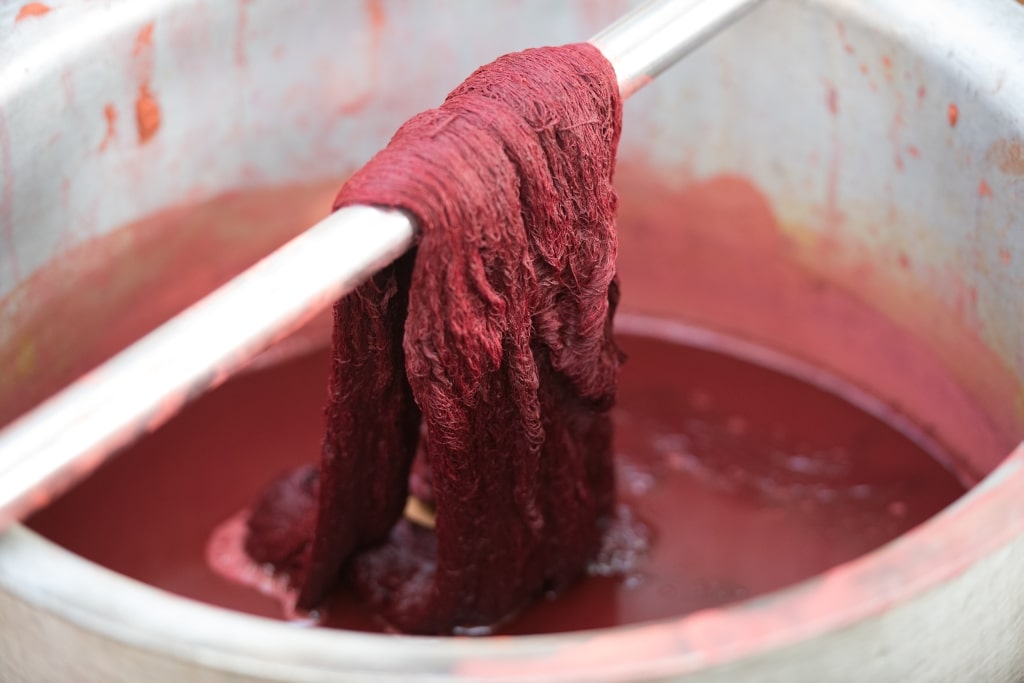
large
align-left
align-right
delete
Recipe 3: Danima, Punica granatum
Color: Yellow
For one warp of yarn of 4.5 kilograms
50 percent Danima by weight of yarn: 2.25 kilograms of Danima
10 percent myrobalam solution or karakkai by weight of yarn: 450 grams
20 percent alum by weight of Danima by weight of yarn: 900 grams
Stage 1: Wash the yarn well
Stage 2: Pretreat with myrobalam for fastness
Stage 3: Mordant with alum for color fixing
Stage 4: Dye in Danima dye solution
Stage 5: Wash and rinse well and dry in shade
The next step in reinventing natural dyeing as new technology was to mobilize the recipes to other locations and dyeing groups. Yet, each place had its own particularity of dye materials, mordants, water, and conditions for dyeing. What then constituted a valid recipe that could travel? Salim, a driver by profession who would go on to become a master indigo dyer, would chauffeur K. V. Chandramouli as we traveled village to village, looking for artisans willing to experiment with natural dyes. On one such trip, Salim noticed that Chandramouli was adding something to the dyebath rather furtively, and came back anxiously to report: “The artisans think the old man is not revealing his secrets, and I now begin to think so too . . . He is adding things without telling us.” When quizzed Sir, as we referred to him, about it, he chuckled merrily and said, “I should have guessed Salim would see. I’m not adding anything new, just adjusting some quantities, because though I give you a standard recipe, sometimes the dyebath needs more than I initially thought.” It became apparent to the artisans and to Salim that there was no perfect recipe; so there could be no perfect translation of color from paper to yarn. The recipe had to be tinkered with each time, even as it provided broad guidelines.
Practices of reading archives and writing made text became important both as the source of the recipe as well as the mode of documentation for the trial recipes that were being worked out. Salim, who was illiterate but had enough letters to use them as a memory aid, provided an important link in shaping the structure of the recipe. In his practice, the recipe, as we see above, became a sequence of actions; it was not limited to materials and quantities, but focused also on stages of dyeing—washing, pretreatment, mordanting, dyeing, washing—using local variants that would still make for fast and deep colors.
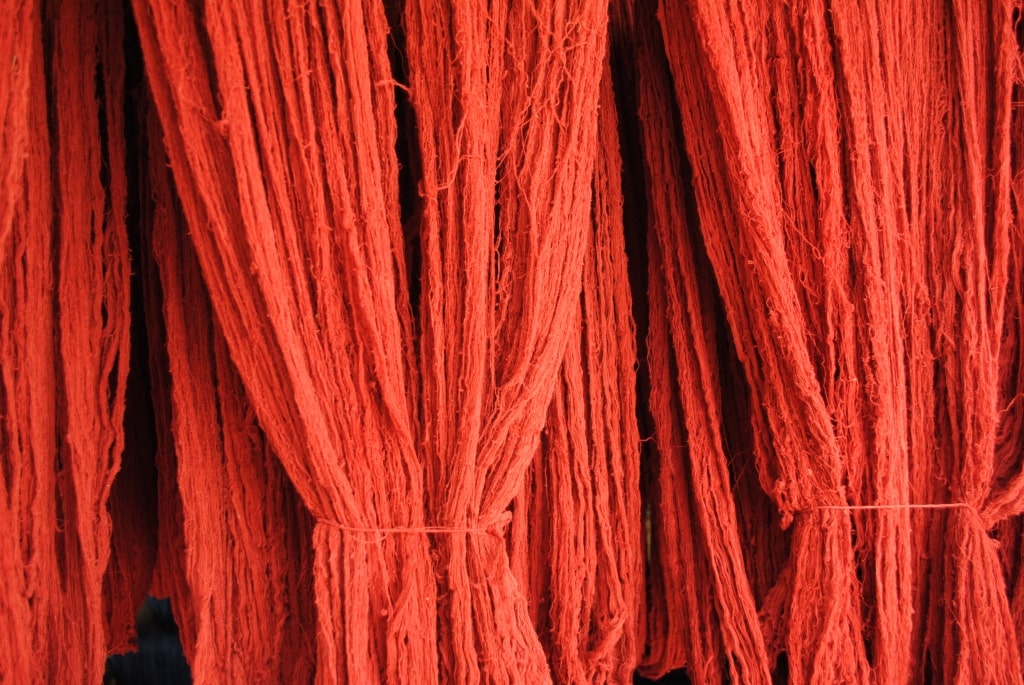
large
align-left
align-right
delete
Recipe 4: Chevalikudi, Rubia tinctoria
Color: Red
For one kilogram of yarn
50 percent Chevalikudi by weight of yarn: 500 grams of Chevalikudi
10 percent myrobalam solution or karakkai by weight of yarn: 100 grams
20 percent alum by weight of Chevalikudi by weight of yarn: 200 grams
For a warp length of ___ meters, the yarn required for warp would be ___ kilograms, and weft would be ___ kilograms. Fifteen days before the current warp being woven is due to finish, yarn has to be washed and mordanted in myrobalam solution. The yarn has to rest for at least ten days, in a cool dark place, before being dyed in Chavalikudi, on yarn pretreated with alum mordant, for good color.
In teaching natural dyes to beginners, Chandramouli had simplified the original recipes, extracted from the routines of weavers from almost a century ago. For instance, there was no longer a daily visit to the river to wash clothes and yarn; the recipes had to be modified to work without flowing water. Similarly, the pretreatment of yarn with myrobalam was substituted with the addition of alum into the dyebath, to fix the color. Indeed, since the weavers of Chinnur had started with the easy ways of dyeing, it became very difficult to convince them of the need to pretreat the yarn before dyeing. As a result, it was Salim who pretreated the yarn in myrobalam before the dyeing, in his own dyehouse in Hyderabad. This yarn was then sent to Chinnur, overnight on a bus, to be dyed by the weavers. The colors were immediately more fast and, quite unexpectedly, much brighter. Odellu, the weaver in Chinnur who led the group, conceded that it was important to pretreat the yarn in myrobalam, and they started the process themselves. But very soon there were complaints from the customers: the colors were much less bright and were not fast. Salim could not explain it: the process was the same, the dye materials the same, yet the color was not.
It was Odellu who solved the problem: “I wondered what it was that a bus ride from Hyderabad to Chinnur could do for the yarn that I could not! And I realized that the yarn needed to rest, to let the myrobalam do its work on it.” He used this insight to improve the other colors too. For example, since Katha has tannin, the material in myrobalam that fixes color on cotton yarn, it benefits from curing post-dyeing; Chevalikudi, by contrast, needs to be mordant with tannin from myrobalam prior to dyeing.
Like Salim, Odellu understood dyeing in the practical terms of active physical engagement, but he also understood periods of rest; what the archival records called “curing.” Interestingly, the processes of waiting and curing, strikingly new to the recipe writers in the beginning, quickly entered the practice of all the dyers and weavers. Conversely, it disappeared again from the explicit recipe of dyeing. Since all mordanted yarn was automatically cured for fifteen days before dyeing, it was not considered necessary to mention curing times in the recipe, and it instead became part of the common knowledge of dyeing practice. In a span of ten years following our initial natural dyeing experiment in the 1990s, more than a hundred different crafts groups started dyeing using natural materials, servicing a growing set of new domestic customers who valued it as a sustainable and green technology of production.
***
This essay started with a recipe of Sir George Watt, a botanist and administrator in British India in the 1880s. The economic dictionaries within which this recipe, along with many others, was recorded were shaped by medical and biological taxonomiesPeter H. Hoffenberg, An Empire on Display: English, Indian, and Australian Exhibitions from the Crystal Palace to the Great War (Berkeley: University of California Press, 2001). and intended to systematize native knowledge. In reviving natural dye technologies more than a century later, the use of these texts as propositional knowledge—a set of formal rules and facts gained through reading and instruction—formed only part of the expertise of natural dyes. To completely retrieve this expertise, the texts needed to be accompanied by full immersion in the way of life of traditional dyeing practices of weavers and dyers. This resulted in the reinvention of traditional natural dye practices as new technology, one with its own protocols, knowledge, and, finally, market standards. But does this crafting of color count as explicit knowledge? How does the informal, constantly evolving recipe help us think about ways for theorizing such embodied practice? Craftspeople struggle with the opposition between practice-based craft knowledge and text-based scientific theories, within which their knowledge is perceived as being less valid and valuable. Instead, thinking of the recipe as a metaphor leads to a way of understanding theory other than as propositional text—theory as a conceptual framework of bodily memory learned over time as habituated craft, “because what’s taken for granted is what counts.”W. Brian Arthur, How Growth Builds upon Growth in High-Technology (Belfast: Northern Ireland Economic Development Office, 2002), 8. Thus, when innovating weavers do not use the intermediate stage of converting their intention into a text, or a plan, or a drawing, but rather invoke the bodily memory gained through previous trials to turn out the innovation being sought. It is the same with indigo dyers, who, given strict instructions by the master to turn the yarn in the vat fifty times, regulate their breath and allow their body to remember the count rather than count aloud, instead focusing their attention on the quality of the color.
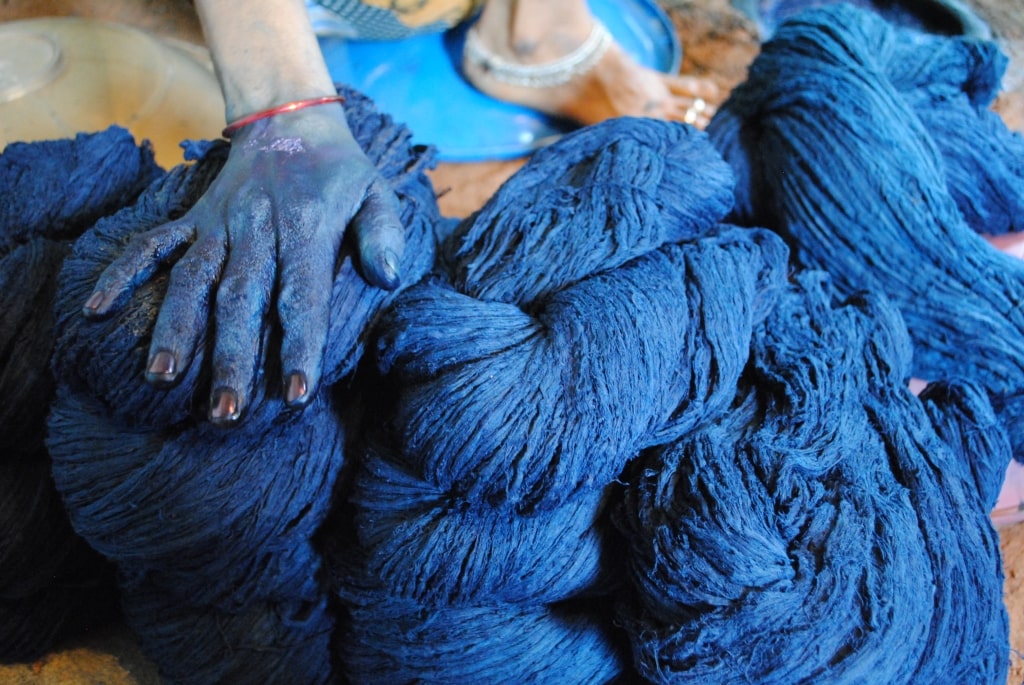
large
align-left
align-right
delete
Science and its theories are generally perceived as existing within a realm of ideas, and written texts become the carriers of these across time and space.Pamela H. Smith, “The Matter of Ideas in the Working of Metals in Early Modern Europe,” in The Matter of Art: Materials, Practices, Cultural Logics, c. 1250–1750, ed. Christy Anderson, Anne Dunlop, and Pamela H Smith (Manchester: Manchester University Press, 2015), 42–67. Texts serve the purpose of “proof,” or validation, developing abstract thought through fostering an internal monologue;Pamela H. Smith, “Why Write a Book: From Lived Experience to the Written Word in Early Modern Europe,” German Historical Institute Bulletin, no. 47 (2010): 25–50. they are perceived to be opposite to hands-on experience, and yet practice can always override them and rewrite them.Pamela H. Smith, “In the Workshop of History: Making, Writing, and Meaning,” Journal of Decorative Arts, Design History, and Material Culture 19, no. 1 (2012): 4–31. Just as formal theory bears knowledge through a process of meaning making that travels between people, places, and time, so do the recipes of craft practice. Just like formal theory, they function as “immutable mobiles,” mechanisms by which knowledge can be stabilized into products that can be physically mobilized.Bruno Latour, “Visualization and Cognition: Thinking with Eyes and Hands,” Knowledge and Society: Studies in the Sociology of Culture Past and Present, no. 6 (1986): 1–40. In this concept of knowledge, theory is knowledge that is stabilized between different iterations of practice—of reflexive practice of the same individual, in the transfer of practices between different groups, and memory practices between past and present. Thus we come to understand a craft notion of knowledge, where theory is never disembedded from its materiality. Instead, knowledge is always in the process of becoming embodied, realized in its entirety only when it is practiced—in this case, to craft color.
© all images: the author